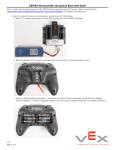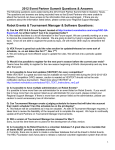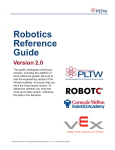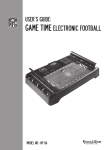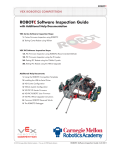Download Mach Motherboard User guide
Transcript
VEX Field Control System User Guide 11.13.2013 Rev B www.vexrobotics.com VEX Robotics, Inc. VEX Field Control System User Guide Page 1 VEX Field Control System User Guide 11.13.2013 Rev B www.vexrobotics.com Page 2 Table of Contents 1. 2. 3. 4. 5. 6. 7. 8. 9. 10. 11. VEX Field Control System Overview..................................................................................... 2 Software Installation ............................................................................................................... 2 Equipment Setup – VEXnet only Configuration .................................................................... 3 Equipment Setup – 75MHz VEX only Configuration ............................................................ 4 Equipment Setup – combined VEXnet and 75 MHz VEX Configuration .............................. 5 VEX Field Control Software Operation .................................................................................. 6 Theory of Operation ................................................................................................................ 7 Normal Operation.................................................................................................................... 8 Debugging – General .............................................................................................................. 9 Debugging – VEXnet robots ................................................................................................... 9 Debugging – 75 MHz robots ................................................................................................... 9 1. VEX Field Control System Overview The VEX Field Control System is used to control multiple VEX teams during a match at a competition or scrimmage. It can control both 75 MHz transmitters and VEXnet transmitters (Joysticks) in any combination. 2. Software Installation DO NOT attach the Match Controller Board to the PC unless you have first installed the VEX Field Control Software and USB Driver per the Installation documentation. Currently the software is written for PC compatible machines running Microsoft Windows: XP, Vista, and Windows 7 operating systems. VEX Field Control System User Guide 11.13.2013 Rev B www.vexrobotics.com Page 3 3. Equipment Setup – VEXnet only Configuration Connect the Field Control equipment per the attached block diagram. Maximum connections to the VEX Driver Interface Board are shown, not all need to be used. After the VEX Match Controller Board is attached to the PC you may open the VEX Field Control Software. Connect the VEX Driver Interface Boards to the Match Controller Board using Ethernet cables. When the VEX Driver Interface Board is plugged in, the associated Match Controller Board LED will illuminate green. Otherwise it will illuminate red. Connect Ethernet cables from the associated VEX Driver Interface to the VEXnet transmitter (Joysticks) COMPETITION ports. A second transmitter may be connected to the primary transmitter using a 4-wire-4-contact (4P4C) handset cable. Only the primary VEXnet transmitter can have a VEXnet Key installed. If the competition has an autonomous period, the robot must be programmed with the associated template/software for the control to work properly. To prevent frequency interference, all WIFI on Channel 1 must be turned OFF. Refer to official game documentation for any over-riding or extra requirements. VEX Field Control System User Guide 11.13.2013 Rev B www.vexrobotics.com Page 4 4. Equipment Setup – 75MHz VEX only Configuration Connect the Field Control equipment per the attached block diagram. Maximum connections to the VEX Driver Interface Board are shown, not all need to be used. After the VEX Match Controller Board is attached to the PC you may open the VEX Field Control Software. Connect the VEX Driver Interface Boards to the Match Controller Board using Ethernet cables. When the VEX Driver Interface Board is plugged in, the associated Match Controller Board LED will illuminate green. Otherwise it will illuminate red. Connect 4P4C handset cables from the VEX Driver Interface to the associated VEX (75 MHz) FM transmitters. If the competition has an autonomous period, the robot must be programmed with the associated template/software for the control to work properly. Crystal management with the 75 MHz system is required to prevent frequency interference. Refer to official game documentation for any over-riding or extra requirements. VEX Field Control System User Guide 11.13.2013 Rev B www.vexrobotics.com Page 5 5. Equipment Setup – combined VEXnet and 75 MHz VEX Configuration Connect the Field Control equipment per the attached block diagram. Maximum connections to the VEX Driver Interface Board are shown, not all need to be used. After the VEX Match Controller Board is attached to the PC you may open the VEX Field Control Software. Connect the VEX Driver Interface Boards to the Match Controller Board using Ethernet cables. When the VEX Driver Interface Board is plugged in, the associated Match Controller Board LED will illuminate green. Otherwise it will illuminate red. For VEXnet transmitters (Joysticks), connect an Ethernet cable from the associated VEX Driver Interface to the transmitter COMPETITION Port. A second transmitter may be connected to the primary transmitter using a 4-wire-4-contact (4P4C) handset cable. Only the primary VEXnet transmitter can have a VEXnet Key installed. For 75 MHz transmitters, connect 4P4C handset cables from the VEX Driver Interface to the associated VEX FM transmitters. If the competition has an autonomous period, the robot must be programmed with the associated template/software. 75 MHz and VEXnet systems can be used concurrently. To prevent frequency interference, crystal management with the 75 MHz system is required and all WIFI on Channel 1 must be turned OFF. Refer to official game documentation for any over-riding or extra requirements. VEX Field Control System User Guide 11.13.2013 Rev B www.vexrobotics.com Page 6 6. VEX Field Control Software Operation Open the VEX Field Control Software. If required, change the Autonomous Period and Operator Control Period (time in seconds) to match the game requirements. Press “START” to start the match. The next screen shot shows a match that has finished the Autonomous Period and is ready to continue with Operator (driver) Control Period. Press “RESUME” to continue the match. The next screen shot shows a match that has completed. Press “START” to start a new match. VEX Field Control System User Guide 11.13.2013 Rev B www.vexrobotics.com Page 7 7. Theory of Operation The VEX Field Control System typically sequences through the game in five states; Disabled, Autonomous Period, Disabled (for autonomous scoring), Driver Control Period, and Disabled (end of match). The 75 MHz VEX robots must have a special software template to allow for this sequencing. The software template will put the VEX robots into autonomous mode for the first xx seconds after powering ON and a valid transmitter output is received. The value xx is determined by the game requirement. After xx seconds has elapsed, the VEX robot software automatically goes into driver control mode. The VEX Field Control Software turns on the 75 MHz VEX transmitter outputs during the Autonomous and Driver Control times. It disables the VEX transmitter outputs at all other times. Note that once autonomous starts, the robot does not receive the transmitter output until the autonomous template has finished. This means that robots running in autonomous can not be stopped by the Field Control System. The VEXnet robots accept an Autonomous/Driver Signal and an Enable/Disable Signal from the VEX Field Control System. They do require a special competition template for proper operation of the Autonomous and Driver Modes , but they do not need special templates to determine the run time of the Autonomous Mode like the 75 MHz VEX robots. The VEXnet robots can be halted by the VEX Field Control System at any time. VEX Field Control System User Guide 11.13.2013 Rev B www.vexrobotics.com Page 8 8. Normal Operation Verify all robots are TURNED OFF. Verify all transmitters are TURNED OFF. Connect the VEX transmitters to the Driver Interface Boards with the provided cables. Verify the VEX Field Control Software Timer is not running, or click STOP to turn OFF the timer. TURN ON all robots. Place them in the starting position and configuration. TURN ON all transmitters. If a robot moves, verify the 4P4C handset cable or Ethernet cable is properly attached to the transmitter. VEXnet NOTE: It does not matter whether the robot (Cortex) or VEXnet transmitter (Joystick) is turned ON first. However, it saves “Link Time” if the VEXnet transmitter (Joystick) is connected to the Driver Interface Board before being turned ON. Click on “START” on the VEX Field Control Software to start the game. Click on “RESUME” on the VEX Field Control Software to resume the game after the Autonomous Period. The software will Auto Reset at the end of the Driver Period and it will be ready for the next match. Disconnect all transmitters from the Driver Interface Boards. TURN OFF all transmitters. TURN OFF all robots. VEXnet NOTE: The VEXnet transmitter (Joystick) must be disconnected from the Driver Interface Board first and then turned OFF. This will allow the robot (Cortex) to turn OFF 3-5 seconds after its Power Switch is turned OFF. Otherwise, the robot (Cortex) will continue to stay ON using Back-up Battery Power if available. VEX Field Control System User Guide 11.13.2013 Rev B www.vexrobotics.com Page 9 9. Debugging – General Verify that the transmitter and robot batteries are fully charged. Close the VEX Field Control Software and reopen it if you have disconnected/reconnected the USB cable or if you started the software before connecting the VEX Match Controller Board to the PC. Make sure that no interfering tasks are running, such as the VEX Tournament Manager Software. 10. Debugging – VEXnet robots First, disconnect the VEXnet transmitter (Joystick) from the VEX Driver Interface. Turn on the robot and transmitter. Verify they link up by flashing green VEXnet lights on both the robot and transmitter. If not, perform the “Pairing” operation with a USB-A to USB-A cable between the robot and transmitter. Then connect the VEXnet transmitter competition port to the VEX Driver Interface using an Ethernet cable. The Robot and Transmitter GAME lights will show the state of the game: blinking yellow for Disabled, blinking green for Autonomous and solid green for Driver mode. If the ROBOT light is blinking fast red, a charged backup battery needs to be attached. The no-backup-battery indication is not displayed if the transmitter is not attached to a VEX Driver Interface Board via the COMPETITION Port. If robot action is erratic: Verify that the transmitter and robot batteries are fully charged. Verify the transmitter and robot will link together if not attached via the VEX Field Control System. 11. Debugging – 75 MHz robots To check for a valid Autonomous / Driver Mode Template in the 75 MHz VEX robots, start with the robot turned OFF. Do not connect the VEX transmitter to the Driver Interface Board. Turn on the VEX (75MHz) transmitter. Turn on the Robot. Try to drive the robot within the first xx seconds. If it moves via your transmitter instructions, then the template has not been programmed into the VEX microcontroller. Reprogram the robot with the valid template. If robot action is erratic Verify that the transmitter and robot batteries are fully charged. Verify that no two transmitters or receivers have the same crystal frequency. Verify the transmitter and respective receiver have the same crystal frequency. Verify that the competition crystals are being used and that proper channel spacing is being used. (Someone in the pits may be using the default or Set A or Set B crystals.) Verify that the (75 MHz) transmitter and receiver antennas are fully extended. Appendix A: Document Version History Date Code Changes 2009-08-14 Initial document release. Nov 30, 2011 Rev A - Corrected various areas and changed board names. Nov 13, 2013 Rev B - Added VEXnet notes in Section 8.









